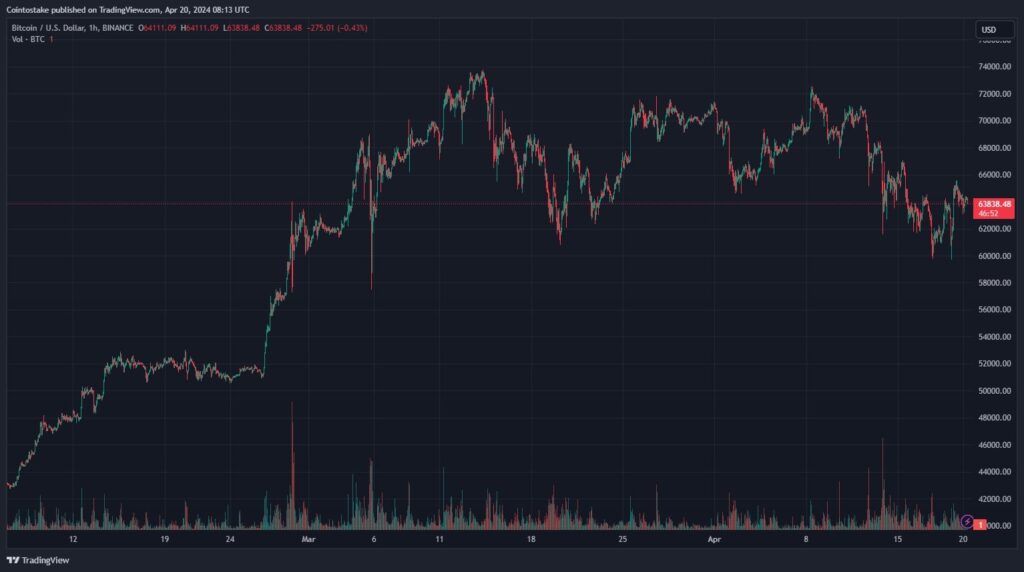
Bitcoin’s price action around the halving event has historically sparked significant interest and volatility. As the cryptocurrency approached its latest halving on April 20, a noticeable price surge underscored the event’s importance to investors. This article delves into the dynamics of Bitcoin’s price rally and the trends observed in the futures markets, highlighting how these elements interplay with broader economic and geopolitical contexts.
The Impact of Halving on Bitcoin’s Price Bitcoin halvings are significant events that reduce the reward for mining new blocks by half, effectively diminishing the rate at which new bitcoins are introduced into circulation. This reduction in supply has traditionally led to bullish sentiment among investors, anticipating a rise in price due to the supply-demand economics.
Prior to the halving on April 20, Bitcoin experienced a sharp price fluctuation. After a 6% drop to $59,640, it swiftly recovered, stabilizing above $64,500. This rebound can be attributed to the optimism surrounding the halving, which often attracts attention from traditional media and influences both retail and institutional investment flows.
Futures Market Response While the spot price showed resilience, the futures market provided a nuanced view of investor sentiment. Despite the price volatility, the total liquidations in BTC futures were relatively minimal, totaling around $45 million. This suggests that while traders were cautious, they were not overly leveraged, a bullish signal underpinning the $60,000 level as a significant psychological support.
Further, the open interest in BTC futures saw a modest increase from $28.6 billion to $29.8 billion around the halving. This slight uptick indicates that the halving did not trigger a dramatic shift in leverage demand, suggesting a stable but cautious market outlook.

Economic and Geopolitical Influences The geopolitical landscape has also played a role in Bitcoin’s price movements. Tensions in the Middle East and other global conflicts have historically correlated with volatility in Bitcoin’s price, as investors often view it as a hedge against uncertainty. However, during this particular period, reassurances from global leaders provided some stability, helping to soothe market nerves.
From an economic perspective, the resilience in U.S. inflation data and strength in the labor market supported a more favorable environment for Bitcoin. Retail sales showing a 0.7% year-over-year growth, along with a robust labor market, helped mitigate fears of an immediate economic downturn, which could have negatively impacted speculative investments like Bitcoin.
Other Articles
Analysis of Professional Traders’ Stance in Futures Markets To gauge professional traders’ sentiment, it’s instructive to look at the premium of BTC futures over spot prices. Typically, a 5%-10% annualized premium is common, but just before the halving, the premium for 3-month BTC futures was at 11%, down from the previous week’s 16%. This reduction suggests that while there was optimism, there was no frenzied speculation. The futures market remained moderately bullish, reflecting a cautious optimism without the rush of short-term speculative betting.
Conclusion The latest Bitcoin halving has once again highlighted the cryptocurrency’s complex interplay with market dynamics, economic indicators, and geopolitical events. While the immediate surge in Bitcoin’s price reflects a positive investor sentiment, the futures market shows a more measured approach, indicative of a mature market that is becoming increasingly intertwined with broader financial landscapes. As Bitcoin continues to evolve, its relationship with traditional economic structures and its reaction to global events will be critical in shaping its future trajectory in both the spot and futures markets.
This comprehensive analysis aims to provide investors and enthusiasts with a deeper understanding of the factors driving Bitcoin’s price and the futures market trends, offering insights into how to potentially navigate future halvings and market cycles.







